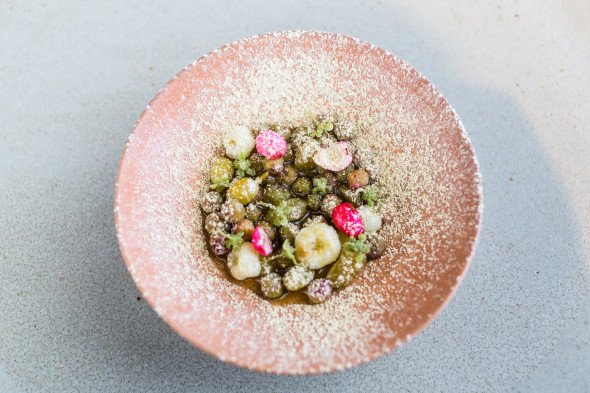
So I’m still in a life-altered daze after eating at Noma Australia – even though my visit was a month ago.
It might seem like wild overpraise to think that one meal could radically affect my oxygen levels and offer so many moments worth freeze-framing. But this isn’t a restaurant where plate after plate is just a punctuation mark closer to fullness – instead, each dish supersizes my curiosity about this country, and every serving is a chance to zoom out and see Australia in a new way.
The Noma Australia story is full of drumroll momentum – and I’m not sure which point to rewind to (the first rumours of chef René Redzepi being in town? The secondhand gossip that he’d take his Copenhagen restaurant – repeatedly the world’s best – and retranslate it in Sydney, as he had in Japan? Or the momentous confirmation that it was all happening at Barangaroo in 2016, with bigwig help from Tourism Australia, Lend Lease, etc?). So let’s redirect the tracks and skip to when the bookings for this 10-week-only pop-up went live online.
It was last October and I remember having multiple alarms on my phone to remind me to get ready, plus having two credit cards out in case one got rejected, and continually revving the ‘refresh’ button on my Internet browser, waiting for the limited number of Noma Australia reservations to drop. I even had a dorky strategy to maximise my chances (and boy, it’s too dorky to even mention). And although there were 84,000 people surging through that booking page each minute, somehow I snuck in and fleetly landed a reservation for two before all 5000+ seats disappeared and the waiting list swelled to 27,000. (Cue the strong buzz of can’t-believe-I-scored-a-booking gratitude afterwards – and an unexpected phone call from a Danish Broadcasting Corporation journalist, who found me via Twitter and interviewed me about landing a seat at a $485-per-meal table, while I ate dumplings in a noisy Sydney food court.)
So perhaps that’s a good starting point – although I could zigzag back and forth forever to find the point that this story really begins for me.
Maybe it’s with that speech that René Redzepi famously gave at the Sydney Opera House in 2010, a talk you didn’t even have to witness to feel its industry-shaking repercussions – his bewilderment about the lack of Australianness on our plates and his hyperlocal focus at Noma acting as a permission slip for us to reconsider what was already here; by magnifying interest in what was in our backyard, he tripped off a renewed fascination with Australian ingredients.
Or maybe it’s when I watch this video where the Danish chef explains who Barangaroo is – and I realise that the name (rebranded in our minds as a long-contested development site, one continually recarved by politics and powered by the ‘need’ for another casino) actually has a strong local meaning and belonged to someone of cultural importance. Barangaroo was a commanding Indigenous fisherwoman who fished on the rocks in this area and, for centuries, the Gadigal people had actually sought out seafood here. There’s something about an overseas figure knowing those details so fluently and an Australian like me discovering that fact so belatedly.
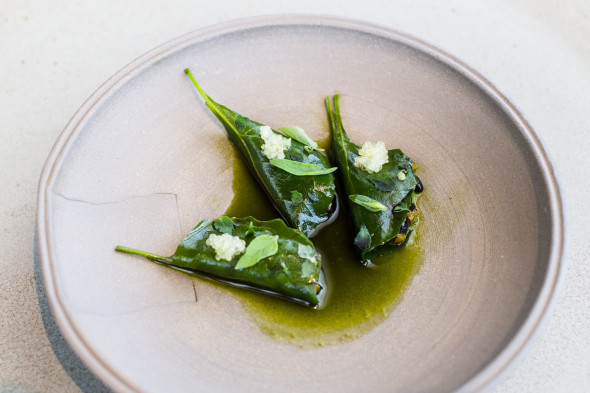
And on the way to Noma Australia, Will says to me did you know that Barangaroo was Bennelong’s wife? I didn’t realise that either and it seems jarring that Aboriginal culture is so often overlooked and sidelined from mainstream coverage. Should we cross-examine our interests and wonder why it takes an international chef like René Redzepi to make us refocus on the Indigenous history that really is the lifeblood of this country?
When you walk into Noma Australia – months after the bullseye-score of securing a booking – you’re taken aback by the cheery restaurant-wide welcome you receive by the many (and I mean many) staff members by the door. It’s like the rock-star “Irasshaimase!” greeting you get when entering a Japanese eatery – except this full-volumed blast of enthusiasm is conveyed by top-of-their-game restaurant personnel (including René Redzepi – a fact that surprised both of us; one of the world’s leading chefs doesn’t really have to energetically say hello to every diner walking to his establishment; his choice to do so only makes it more inviting).
Cooking with fire is a life-spark of Australian cuisine – from ancient Aboriginal ways of grilling with hot coals and baking with ashes to today’s barbecues and their summer-long soundtrack of sizzles and hot-weather hissing – and it’s a big influence on the Noma Australia menu. You can see how it’s inspired the restaurant’s interiors as well: from the earth-warm palettes to the “charring” finish on the direct-from-Denmark chairs (Foolscap Studio collaborated with Carl Hansen & Sons just to get that effect). The design was also influenced by the smoke-and-burn of bush regeneration and the horizon lines of both land and sea.
The menu, too, is a character study of the Australian landscape that feels wildly alive.
And, by the time all 12 courses are over, Noma Australia has radically remapped my understanding of this country’s high-contrast terrain: the sun-locked coastlines, its hardy dessert, its tropic-charged rainforest and all the eccentric contours and climates in between.
These geographic reveals are gradual and subtle, though; and, likewise, there’s no showy undercurrent to what you’re served. When each dish meets your table, nothing on the plate feels like it is desperately auditioning for your interest, but every detail turns out to be worth a headline-hold on your attention. Three courses in, I end up thinking this is already one of the best meals of my life.
But, first, let’s rewind and flip back to the opening dish.
It’s a chilled broth, served on ice. Floating through are thin planks of unripe macadamia. The pure-concentrate nutty overload of these slices is a brilliant jolt. The cool liquid – made with miso, cultivated in the basement with spores from Noma’s lab in Copenhagen and coloured with drops of rose oil – is so clean and bracing, that it wakes you up in the best way. (The broth, by the way, is typically made with spanner crab, but as you might’ve figured, my menu is the vegetarian version and nothing on it feels like an afterthought or just ‘second-rate’; as I’ve written, I’ve always been inspired by Redzepi’s realisation that vegetables could be more than garnishes, that they could become “lead guitarist” of a dish.)
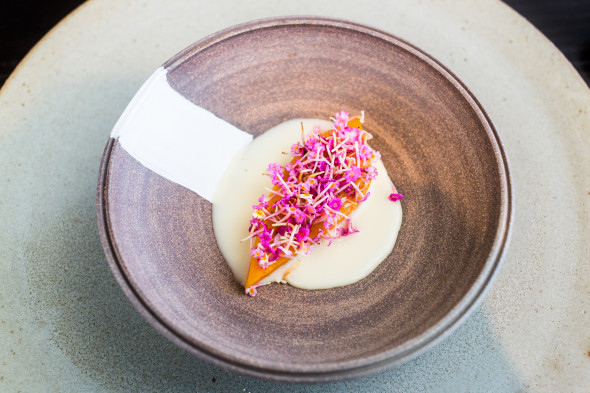
I learn that we are sitting next to the macadamia farmer who has supplied the key ingredient to this culinary kick-off. Apparently, he had to completely reconfigure how he harvested the nuts to carry out Redzepi’s request that they be supplied green and unripe. And in fact, the macadamias are so raw and tough that they have to be sliced open with a saw. (Our waitress told us it had taken her many, many tries to get it right.) As Lisa Abend wrote in her fantastic dish-by-dish coverage of Noma Australia, it requires 15 apprentices, 16 kilograms of nuts and two hyper-focused hours a day just to ready the macadamia slices that end up anchoring the dish like stepping stones.
Two different Noma staffers tell us the next dish is their favourite. It’s also the only truly vegetarian course on the menu (which is really a big-time valentine to Australian seafood; check out Redzepi’s Instagram feed, it’s pin-up shots of shellfish after shellfish; he’s a guy that crushes majorly on spanner crab and marron).
This is a bowl of native berries that have survived contrasting, tough climates across Australia (from flood plains and beyond) – so, as sous-chef Beau Clugston explained, their flavour is straight to the point. And as I wrote on Good Food, you can really taste the battle in each fruit. The punk symphony of muntries, riberry, lilly pilly and two types of lemon aspen is an unguessable chorus of flavours with each spoonful – I can see why it’s a staff favourite. The raw and punchy cluster of tart, citrussy and barely-sweet notes reveals a different harmony each time. Lemon myrtle, earthy kelp oil and a dusting of gubinge (Kakadu plum) add to the untamed feel. In fact, the gubinge powder feels like a bush sherbet – and hints at why a Noma Australia meal clocks in at $485. (Lisa Abend writes that the powder costs $500 a kilo and just as Redzepi told his kitchen not to be careless with such a pricey ingredient, the air-conditioning powered to life and blew the expensive powder everywhere, just like that Annie Hall scene where an ill-timed sneeze sent a whirlwind of cocaine out of commission.)
Beau Clugston, who is originally from Coffs Harbour, says he’d always associated the native ingredients in this dish with cosmetics – and he wished he’d been more aware of what was available here before he’d left Australia and ended up in Noma’s research and development kitchen in Copenhagen. But Indigenous produce hasn’t exactly been a spotlight hog; native ingredients have (mostly) had a low profile until recently, so it’s no indictment or surprise that it’s taken his return with Noma Australia – and a country-wide research mission to unearth what’s unique about our landscape – to realise the culinary jackpots that are part of our terrain. (And even then, it’s been tricky to acquire adequate amounts. He said that there was a week left of white aspen before their supply of the fruit was gone.)
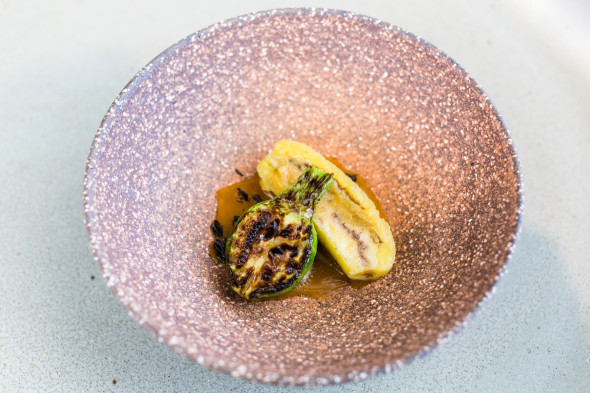
Not being conscious of the rich ingredient basket that Australia offers is kind of a running theme for most people (and something I’m guilty of, too): Morgan McGlone, the chef who runs Belles Hot Chicken a few doors down, is from Lilli Pilli. He used to eat the aforementioned berries in this dish all the time, but didn’t realise how great they were until he had Noma’s vibrantly realised version.
And here’s another flashback: in high school, my one run-in with “native produce” was a class where we cooked with kangaroo and wattleseed. I remember making shortbread with crushed wattleseed – and the default way the coffee-like sprinkles end up in biscuits has defined this ingredient for me. Noma’s take is a category-shattering version of what you can do with it.
The restaurant’s wattleseed ‘porridge’ involves two versions of its star ingredient: golden and desert oak. Clugston says they were inspired by how wattleseed is cultivated (which involves boiling the seeds in smoked water before you push them into the ground), so to prepare this course, they pressure-cook the wattleseeds for around eight hours. The wattleseeds – which are surprisingly big and beady (like black beans) are still crisp and crunchy, so they must be tough as hell in their OG dare-to-take-us-on state. Here, they’re wrapped in saltbush leaves, bathed in a slick of anise myrtle and topped with tart bubbles of finger lime. The whole dish is like tasting different ripe and crunchy sweet shades of green.
Now, until this point, everything we’ve tried has been a vego-friendly edit of what’s on the standard Noma Australia menu. The next two courses are originals and they are fantastic.
The first is an island of pumpkin that’s been decadently roasted in rye oil, so the flavour is richness unbound. It’s banked in a low-tide wash of fermented barley sauce, which is created from moulded barley and butter (it’s Noma’s re-authoring of beurre blanc); the after effect is light, creamy and radiant – each spoonful regenerating hidden dimensions that surprise and linger. A wild freefall of lantana petals sits on top.
The next one is Will’s favourite. Here, Noma weaponises unripe banana and zucchini with fire and char – to powerful, smoky effect. The fruit is cooked, skin on, directly on smouldering coals and all this burn and blaze has the hyperspeed impact of turning unready, still-raw flavours into an intense, flame-branded savoury force, with the kiss of cinders and caramel boldness. It’s the best kind of time-lapse effect. The zucchini is charred just on one side and left medium rare. The banana and zucchini are propped against a bold swoop of egg yolk, miso and lemon thyme.
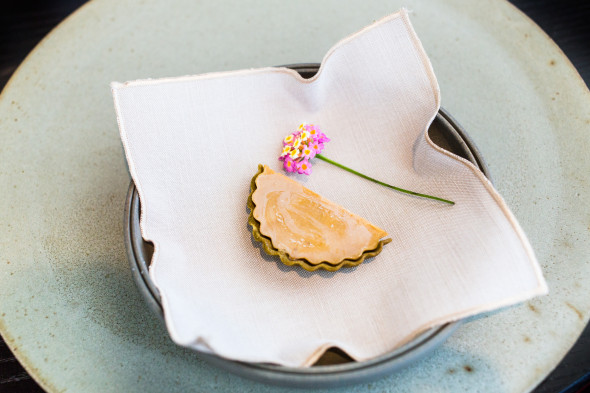
If someone offered you a “pie of dried yeast”, I doubt you’d say yes. In fact, it sounds like something you’d bake if cornered into making something for your office arch-enemy’s birthday and wanted to guarantee a dud time for everyone (and zero requests for seconds). So, the name probably needs a bit of PR shine, but the reality is that Noma could christen their dishes after stomach viruses and they would probably still taste great. This pie is ultra-nutty and earthy, and delicious in a surprising way – like the flavour hits you on time-delay. Inside the kelp crust is baker’s yeast that’s oven-roasted until it starts getting wild umami readings. The inclusion of beeswax and grapeseed oil adds texture and viscosity – and a kind of cryptic layer that you try to puzzle out. None of this tastes ‘obvious’, so it’s like your brain has to refresh its cache to work out that you actually like the combination.
The pie is served with lantana – yes, that famously invasive weed (in fact, when we show a photo of this dish to Will’s mum later, she near-hisses at the lantana; even in plain pixel form, it inspires such animosity, because it’s a gardener’s life-long nemesis). Parts of the plant are poisonous, but not the blooms, so we’re instructed to adorn the pie with the non-toxin-wielding petals. So we channel flower girls at a wedding, by plucking and scattering all that prettiness over our plates.
Next is the “BBQ’d dumpling”, which is really a taco gone undercover. In fact, because it’s made out of caramelised milk skin, it also feels like an Asian dessert crepe that’s gone into witness protection. No matter the name you want to sling at it, it’s that great coinflip of being both ultra savoury and potently sweet at the same time – it’s flat-out dazzling levels of delicious. Usually, the crisp dumpling houses fresh marron and a ragu of magpie goose (and Redzepi’s championing of the ancient bird found in northern Australia, incidentally, could lead to the first commercial licence to harvest it). For me, though, there’s confit avocado and nasturtium hidden inside the crepe-like folds – and the blowout caramel sweetness is a card-snapping match for the barbecued milk skin. A party-popper of finger lime sits nearby – all that spring-loaded citrus fires off fresh cut-throughs across all that intensity.
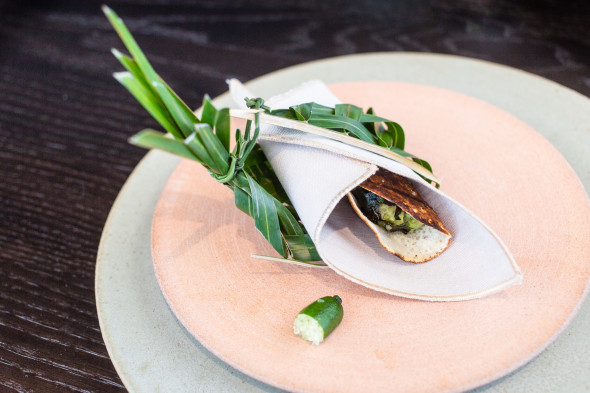
In Tienlon Ho’s brilliant feature on Noma Australia (honestly, it’s so intensely good that I nearly cried the first time I read it), she writes that, “Redzepi was wondering why everyone in the world wasn’t using bush tomatoes, which tasted something like piquant sundried tomatoes marinated in soy”. They, of course, end up making a cameo on the final menu. The chef who serves us says that they’re cooked so fiercely that they shrink to a third of their size, becoming so sweet that she compares them to pieces of candy. Ours come combined with elderflower oil and a shiitake condiment that tastes like porcini cream. It’s great, but Noma hitches its standards so high, that this isn’t even the biggest standout. This would be the best dish at another restaurant.
The menu’s abalone schnitzel has scored a lot of screen time (and a good reign on Instagram). I think everyone got a kick out of one of the world’s leading restaurants having undisguised love for such an Aussie pub favourite. Of course, Noma reconfigured the schnitty so it wasn’t just a carbon copy of the over-the-counter $10 special you see everywhere. My take is made with shiitakes (apt, given how often they’re the vegetarian understudy for abalone in Asian dishes), which the chefs marinate in porcini oil, koji and a spin-off of Noma’s Vegemite. Crumbed and fried, that would be attention-seeking enough. But what draws you to the dish is the clockface of native condiments that surround it – from sea pearls and ice plants to an Atherton oak nut. Each one has a story behind it, from the mat rush that you would’ve brushed past on your last beach visit to the bunya nut that’s so ancient that it dates back to the dinosaur age (Beau Clugston explains it was also so hard to grow – with years and years between any kind of success – that First Nations communities would throw a bunya nut party when they finally could harvest the trees).
When I mentioned this dish to Mat Lindsay when I was at Ester the following week, the chef said that they actually had a bunya nut tree at school. The falling cones were so big that they fell on two different kids and cracked their heads – and so the tree had to be cordoned off. “No one knew we could eat from it,” he said.
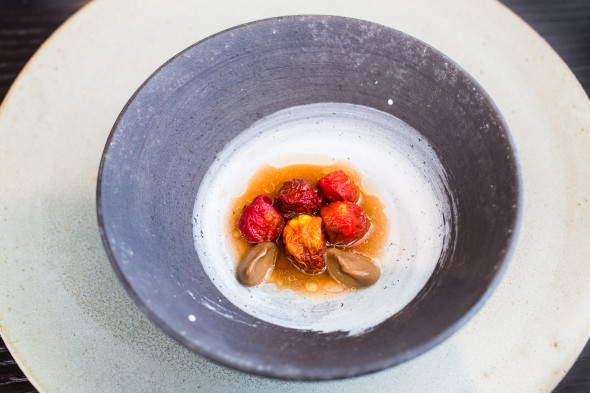
(And snap – when I interviewed Corie Sutherland of Edition Coffee Roasters, who makes a coffee for René Redzepi every morning and is, in a way, Noma’s personal barista, he said of the schnitzel’s coastal condiments: “I kick that shit around on the beach all the time, I never thought I could eat it.”)
Just more examples from my growing evidence file that Noma Australia has really schooled us locals on what we have here.
Given Redzepi’s outsized crush on mangoes (as chronicled in the Good Weekend profile, where he created a quenelle with his spoon from a perfect specimen), it’s no surprise that the first dessert features the tropical fruit. It’s served as a mango sorbet sandwich and is like an XS-sized version of the best Weis Bar you’ve had. It’s backed up with watermelon compressed in Davidson plum and pineapple in hibiscus flower – they’re really side shows to the mango headliner. Oh and of course, Will’s version had green ants frozen mid-step in his. I remember reading in Redzepi’s A Work In Progress journal that the ones they serve in Copenhagen have this citrus burst to them; in Australia, people have compared the effect to the zing of lemongrass or makrut lime. Will said the dessert overpowered any discernible taste, though. (Cue another flashback: Will’s brother actually ate green ants as a kid – his mum told us about how’d he describe the sting of flavour; as a kid, he really was many paces ahead of the culinary zeitgeist.)
Kim Mikkola, a Finnish chef from the test kitchen, serves us the next dish – and he is straight-up awesome. He energetically says, “ha, what, you thought you already had enough fruit?!”, before landing down a plate of Mirabelle plums that they’d foraged in Canberra. This led to us cracking jokes about how Canberra was good for something besides legal fireworks and not-so-legal drugs (Will grew up in the ACT capital, so we’re allowed to aim the odd tomato at his previous home town.) The plums come with these native pepperberry twigs – the chef suggests we chew on the bark, for a little fiery hint, but warns us against attacking the berries or leaves. “It will ruin your palate for hours.”
He also instructs us to spear the plums with the native pepperberry. The plums are like less intense cumquats – imagine a sound engineer taking the high-pitched flavours and turning the levels down to the point they stopped making you squint. The impact is pretty understated, even with the stabs from the peppery twigs. (Incidentally, someone has to sharpen those pepperberry twigs everyday – just as Noma staff have to individually hand-weave the leaf baskets for the barbecued dumplings; our charming section waiter Charlie is on basket-creating duty and says he really enjoys it. It just speaks to the level of detail you see in every dish.)
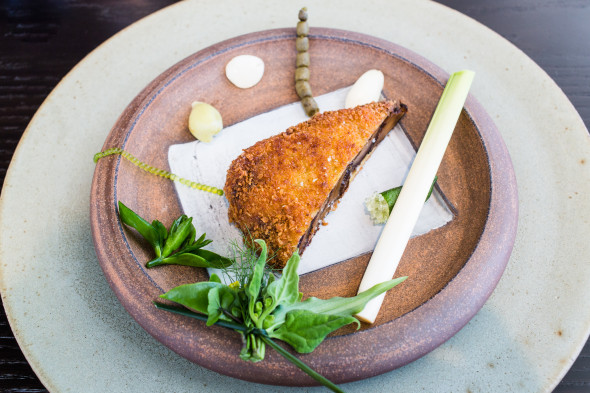
Noma Australia takes on another Australian classic with its translation of the lamington – “our sort”, they told us, and the chefs have flipped the choc-coconut cake inside out, in the best way possible. All the chocolatey, jammy richness has been subtracted, and instead you end up with a lightly aerated rum lamington, given a good shakeout of milk crumbs, and flavoured with rainforest lychee and native tamarind.
Not only is it a cool, flash-frozen and airy dessert – struck with mealy crumb textures and a lick of sweetness where you’re not looking for it – but for me, it was yet another Noma-sparked crash course in the country’s expansive food bowl. I had no idea that rainforest lychee even existed here or that Australia even grew native tamarind.
The last dessert is the “Baytime”, which pastry chef Malcolm Livingston II explains is a tribute to the local Gaytime ice-cream, and the name is a reference to the neighbouring bay and also a cheeky way to outsmart copyright lawyers. It’s actually more like a Magnum, and it makes you wish that all desserts could repeatedly hit this high point. The ‘ice-cream’ is coated in butter-blitzed and toasted freekah, which turns the do-gooder ancient grain into a shockingly great impersonation of rich chocolate; inside is a peanut milk ice-cream and a spunky citrus toffee streak, all plunged into a stick of lemon myrtle. It’s so good that we should start a national campaign to get Streets to make a version to spruik from its freezer cabinets. I know someone who was luckily enough to land two Baytimes when they dined at Noma Australia. Even Redzepi can’t deploy his defenses against this willpower-proof dessert – Lisa Abend writes that they have to make four extra ice-creams for him every day.
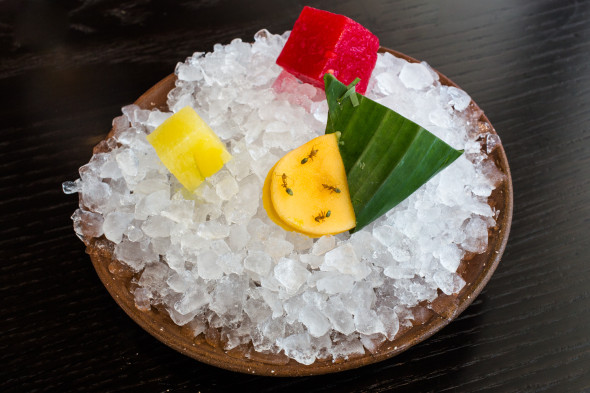
And the petits fours, by the way, are these dessert lime and apple sweets that are like fruity cellophane that dissolves in your mouth.
So now that I’ve blown a billion words on the food, I should probably dispense a few on the drinks – which share similar DNA to the menu, with an inventive focus on the local and a wry dose of humour when needed. Sydney legend Mike Bennie teamed up with sommelier Mads Kleppe on the alcoholic matches, which includes many custom-created drinks (such as the Snakebite made with Two Metre Tall’s Ashley Huntington from Tassie; it’s an upgraded and bespoke version of the cheap cider/lager mix that students usually drink to get blasted); of course, there are many other highlights, including Bennie’s own Brian riesling and a butterscotchy Lucy Margaux chardonnay. (The sake is the only non-Australasian drop I remember making a cameo.)
When I wrote my Good Food story on the rise of inventive non-alcoholic drinks in Sydney earlier this year, I discovered that it was Noma’s juice program that inspired Ben Greeno and Clayton Wells (both former Noma alumni) to start the first one ever in Australia at Momofuku Seiobo (which has since led to people toasting non-alcoholic pairings everywhere from Orana to Attica interstate, and Bentley and Quay locally), so it was a nice full-circle note to try Noma’s OG iteration here in Australia.
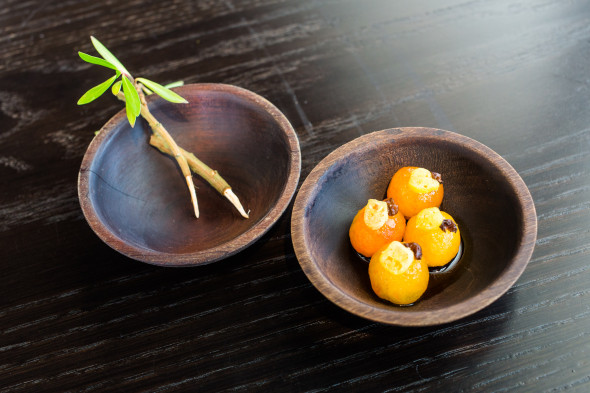
It’s a fascinating mix and (even though “juice pairing” is often the default name for booze-free matches), none of the drinks are really a traditional juice. They’re a mix of ingredients you wouldn’t think to pour together in a glass – like smoked pepper and red pepper berry or rose and spruce wood oil. The opening bergamot kombucha with native mint speaks to how much invention they swirl through each drink (and how they’ve drawn from such an Australia spectrum of flavours). It’s the gazpacho-like punch of the green tomato with lemon myrtle that I remember most (although the blood plum with native thyme was the perfect dessert-chaser). The native mint tea (with finger lime peel and the native fennel flowers you find all over Sydney) was a soothing full stop to the meal, too.
There’s been a lot of coverage about how expensive the meal is (especially if you tally up $215 for the wine pairing, $95 for juices and $10 just for a tea, on top of the $485 baseline for the food), and I’ve sat through the crossfire of both chefs complaining that the prices are pitched too high for what it is and the countering arguments that Noma is paying a premium for top-grade or hard-to-source produce. All I can say is, yep, it is a lot of money, as my bank-balance-staring has reminded me (and it’s a hefty amount I’ve personally paid for, it’s not a work expense or tax-deductible write-off; Will even paid his half back to me in installments, like old-school lay-by). But for a lifetime-best meal and an experience that was like a magnifying glass to the wonders of the Australian landscape, it was totally worth it. And as Corie Sutherland said when I interviewed him, you walk away from Noma Australia with more than a full stomach.

I’ve also been impressed by all the efforts the restaurant has undergone to work itself onto the city’s honour roll – letting student chefs dine for free, mentoring Indigenous trainees and auctioning off the final service for OzHarvest and MAD. So the person who offered Corie Sutherland $10,000 for his Noma booking might get to go now!
Also, Noma is selling Louise Bannon’s fantastic bread for a great cause – for $15, you’re buying one loaf for yourself and another for The Wayside Chapel. (Made with rye, whole wheat and a bit of freekeh, the bread is spongey-soft inside, but the crust is dense and malty and will definitely give your jaw a workout, the loaf offers such a proper, satisfying chew. Grill it on the toaster and it’s smoky and the crust has a caramelly flourish. It’s bread so good that it’ll ruin other bread for you. Find it next to Belles Hot Chicken, active between 10am-12pm and 3-5pm before it winds up on Friday.)
I’ve also loved having my Noma Australia enthusiasm resparked by every article, every Instagram pic and every run-in I’ve had with someone who has been. When I was there, I saw another diner in the bathrooms and asked how she was finding the experience. She joked that she was still pulling ants out of her teeth. I also wanted to know her reservation-scoring story. She said her friend had actually been on the wait list – and they got the call just yesterday, asking if they could make it. (So yes, even out of the swell of 27,000 people, it is still possible to end up in Noma Australia, even if the odds seem so wild.)
Recapping the memory-bank-worthy meal with other diners has been brilliant fun, even if they haven’t enjoyed every single dish. A lot of people have said they were challenged by the menu and sometimes deliciousness didn’t always seem like it was an obvious end goal. Some people flat out did not love the scallop pie or the crocodile fat dish on the standard menu, either – but, overall, the batting average for Noma Australia has been incredibly high. It would be hard to beat its winning streak.
The menu has also had been reconfigured a few times over the 10-week pop-up and I’ve relished observing the trainspotting differences. Analiese Gregory (who has just opened the fantastic new Bar Brosé) got to go twice (!) and told me of savouring the avocado dish with smoked butter and black truffle paste – “it’s like vegetarian foie gras”, she said. Callan Boys had the monstera deliciosa, which he hilariously described as resembling “a corn that’s really let itself go”.
Of course, René Redzepi wasn’t the first to direct our field of vision to native ingredients; both John Newton and Simon Thomsen have name-checked Jean Paul Bruneteau and his 1980s restaurant, Rowntrees; Pat Nourse, who snuck in with the first online review of Noma Australia, made an illuminating point in Gourmet Traveller about foreign-born chefs – like New Zealand’s Ben Shewry at Attica and Scotland’s Jock Zonfrillo at Orana – being at the forefront of pushing these Australian flavours. And you could name many locals – such as Kylie Kwong (who is appearing at Redzepi’s MAD Sydney this weekend), who have been showcasing salt bush, wallaby, Warrigal greens and other native produce on their menus.
But I do remember, not that long ago, going to a place like Cafe Ish in 2008, and noting how it wasn’t that common for an eatery to so overtly push Indigenous ingredients, like a wattleseed coffee or a dessert with riberries. Even the owners remarked how unusual it was at the time.
And it’s interesting that the question of why it took someone like Redzepi to make us re-look and appreciate native flavours is the focus of two works I know of (John Newton covers this in his upcoming book and my friend David wrote his thesis on it – it was due the day Noma Australia bookings went live and when he ate there, his paper got outed to staff by an enthusiastic friend of his; Redzepi ended up talking to him about it and asking for a copy). I don’t have the answers, but I’m grateful that Redzepi, Clugston and crew radically directed their searchlights across this country – from experiencing exploding mud clams to reconfiguring Vegemite in their own way – and magnified what Australian cuisine could be in the process.
(Also, before I wind up, can I just say how next-level the service is at Noma Australia? I know the restaurant has a luxurious amount of floor staff by Sydney standards, and few local establishments could afford that, but wow, the friendliness, the enthusiasm, the knowledge and the lack of judgment when I was compelled to slurp the bowls clean – it was astounding. I’ve never seen a workplace powered by such undiluted cheer; Noma Australia is a group portrait of really happy staffers.)
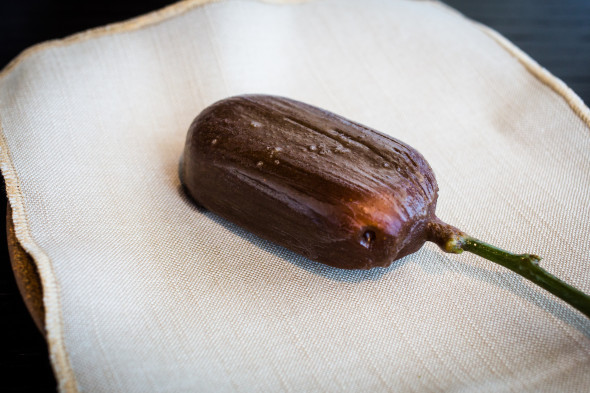
Yes, I’ve had standout meals with a strong local focus (like at the great Sixpenny, where I’ve eaten ice-cream made from emu eggs and dishes built from ingredients so close by that they could be measured not in food miles, but food footsteps), but Noma Australia was the first to offer such a panoramic sweep of the country. Sitting there, I felt like I had an optimised, high-definition and beautifully colour-graded view of the entire landscape. Dish by dish, the menu ended up as shorthand for a geography lesson, a history class, a tribute to Indigenous culture.
The whole experience felt alive and symphonic, too – not like staring at a flat museum wall and forcing myself to digest it all.
I felt like I had learnt a new dictionary at the end.
By this weekend, Noma Australia will be over; for me, it will exist only as something to reconstruct in my memory – but I think its effect on Sydney will be supersized. I’m so glad I was there for it.
Tags: Barangaroo, Noma Australia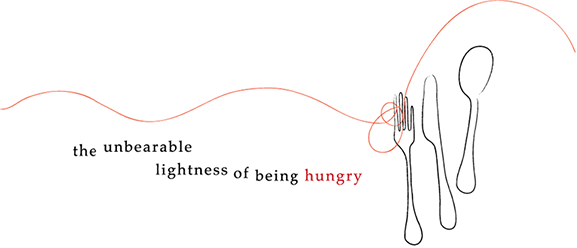
I really loved this. A lot of people have written about the experience at Noma and I’ve read a lot of them but this was my favourite. Thanks for taking so much time to share your thoughts.
I really wish I had been able to to enjoy the same experience but I’m looking forward to enjoying it in all the influences it has across Australia’s restaurants.
Wow, Nick, thanks so much for taking the time to drop such a generous comment! I know, there has been so much coverage of Noma Australia (which is great, I’ve enjoyed reading every page, every blog post, every Instagram comment!), so I am really amazed and happy to hear that this was your favourite. Thank you!
You’re right, it took me ages to battle this piece out and many 3am/4am bedtimes to get to the end. But I’m glad I slogged it out in the end.
I wish you had had a chance to go, too! Knowing how much you enjoy food – and observing/studying all the levels of thought and vibrant detail and cultural specifics that go into particular meals, I think you would’ve really loved every moment of it.
I think you will definitely feel the after effects of Noma Australia’s time here. I just saw the other day that someone was trying to sell packaged Kakadu plum in supermarkets! I think we will get a renewed sense of what Australian flavours can be and that is a great thing.
I felt like a lot of pieces on Noma were looking to answer the question ‘is it worth it?’ and were mainly review based because of that but I thought there was something much more interesting to talk about and that was a new flavour palette of Australia, and all the social-historical ramifications of it just being appreciated now.
I’m really excited by the idea that a lot of chefs who ate at Noma will be bringing these ideas and ingredients to their restaurants. Hopefully with curiosity and courage, knowing that they taste good and people are willing to eat/buy them.
It will be interesting to hear what Redzepi says at MAD. Will you be doing?
Hey Nick,
How are you?
Thanks so much for your very generous and thoughtful comment. I wrote a long reply to it ages ago and assumed that it got published, but now I see a very incriminating silence where my response should be! Apologies. I have a feeling I wrote it while in a cab and was too dopey/distracted paying the driver to hit the all-important ‘reply’ button! In any case, yes, there was a bit of that “stop/go” or “green light/red light” kind of consumer criticism (kind of like the “should you buy this record” type of music review), even if it was kind of beside the point, because no one could really book in a new spot at Noma after the reviews appeared (unless you had big pockets for the charity auction at the end). I’m really excited, too, by the renewed focus on Australian ingredients, too, and what the Noma Australia legacy will be. Thanks again for your very kind comments about the blog post.
I enjoyed MAD SYD, especially what Redzepi had to say – also, he has the most amazing collection of Australian souvenir shop T-shirts, BTW. He also, like Chang, could call BS on certain things or at least joke about the foraging backlash and contend with the haters that would send him photos of themselves smoking weed as their versions of “foraging”. It’s cool that he’s able to influence the Danish curriculum and inspire kids to connect with the landscape through foraging and feeding themselves from natural surrounds.
Hey
I’ve just had some kakawa and I’m looking forward to going to bed early so really good I’d say.
No worries on late reply. Did you write anything on MAD for GF? I wrote something for GT and it took me an incredible amount of hours to produce something very simplistic. It was a draining experience.
I enjoyed the day but I wanted more, to go deeper. The panel at the end was good but to be totally honest I thought a few of the talks didn’t bring much to the day. Although they were all engaging some just had very little to do with tomorrow’s meal.